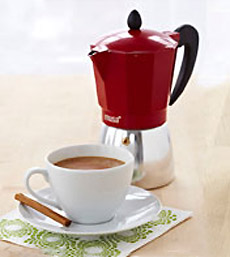VALENTINE GIFT: Red Moka Pot
 The classic moka pot dons a red coat. Photo courtesy IMUSA USA. |
Here’s a no-calorie Valentine gift for someone who loves strong coffee: a red moka pot.
You can purchase the six-cup version at Macy’s for $14.99; it also is available in pumpkin orange and cobalt blue. A three-cup version is available at Kohl’s. Bialetti, originators of the moka pot, make six-cup versions in solid red, orange, blue and violet. Up until few decades ago, before the introduction of electric-powered espresso machines for the home, people with money made espresso in a moka pot, a manual Italian espresso maker. People without money, space or a frequent need for an electric espresso machine still do. WHAT’S A MOKA POT? A moka pot is a stove top coffee pot that makes strong coffee. Instead of the more recent drip coffeemakers, where water drips down through ground coffee into a carafe below, the moka pot holds the water in its bottom half. When heated on the stove, the steam pushes boiling water up through the grounds into a top chamber, from which it is poured. |
|
|
HISTORY OF THE MOKA POT The aluminum Moka Express, with its octagonal body, was patented in 1933 by the Italian inventor Luigi De Ponti and acquired by Alfonso Bialetti. It enabled Bialetti, a metals engineer, to transform his company into a leading Italian coffee machine designer and manufacturer. Before the moka pot, only people of means could brew café-quality coffee at home, using large and expensive commercial machines that required training. Most people drank their coffee at a café or coffee bar. The creation of the small, efficient, user-friendly and affordable Moka Express allowed anyone to quickly brew at home the bold, robust-tasting coffee beloved by Italians. It replaced the more primitive coffee-makers developed in the late 19th century such as the Napoletana. Although today there are electric moka pots, it the original survives in its original form—a feat for a kitchen appliance designed more than 80 years ago. The major change has been a move to stainless steel by some the versions, as well as novelty designs like the one above and Bialetti’s cappuccino moka pot with a fun cow-pattern enamel coating (there’s also a plain, elegant cappuccino pot). |
||
|
WHY IS IT CALLED “MOKA?” The Red Sea port city of Mocha in Yemen was the major marketplace for coffee—grown in Africa—from the 15th century through the 17th century. The principal port for Yemen’s capital city, Sana’a, it was later eclipsed by the ports of Aden and Hodeida. Because the name is transliterated from Arabic letters, there are a variety of spellings: Mocha, Mocca, Moka, Mokha, etc. Even after other sources of coffee were developed, Mocha beans (also called Sanani or Mocha Sanani beans, meaning “from Sana’a”) continued to be prized for their distinctive flavor—and remain so today. |
 Be my Valentine—have an espresso. Photo courtesy IMUSA USA. |
|
|
HOW TO BUY A MOKA POT Remember that a “four cup pot” means four wee espresso cups. If you like a double espresso—or a standard coffee cup full—buy the largest pot you can find—typically nine cups. Bialetti’s largest makes 12 cups. If you have the option, stainless steel will look better over time than aluminum. Typically, Italian roast coffee is used in a moka pot; but you can use whatever you have. What if you have two moka pots? Use one for tea. See our moka pot tip from ten days ago.
|
||


